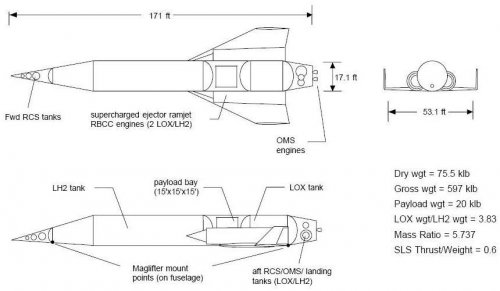FutureSpaceTourist
ACCESS: Top Secret
- Joined
- 10 March 2010
- Messages
- 590
- Reaction score
- 34
Between 1995 and 1998 NASA funded a study into Highly Reusable Space Transportation (HRST).
[quote author=http://science.ksc.nasa.gov/shuttle/nexgen/hrst_main.htm]
A rocket works by combining fuel with oxidizer, but all the oxygen, unlike cars or airplanes, is carried aboard the rocket. Not so for cars or airplanes. The physics of a rocket mandates that most of the rocket at lift off is thus propellant. Most of a rocket's weight is not rocket structure holding the propellant nor other parts of the rocket. By weight, a rocket at liftoff is mostly propellant. Some numbers - a typical passenger jet plane may be 30% propellant, in this case jet fuel, and 70% aircraft, by weight. For comparison, a rocket may be in the range of 85% propellant and 15% rocket, by weight. This 15% does not make for an easy design that will be robust and can focus well on affordability, ease of operation, reliability or safety. At 15% of something to hold 85% of something else, the preoccupation is mostly on getting off the ground, and if need be return, such as with the Space Shuttle. Expendable launch vehicles do not significantly depart from this basic reality. Separating and dropping stages during ascent is simply a means of discarding structure that is no longer required for the rest of the ride, but which was still just as fragile and weight limited.
Now imagine some of the oxidizer was taken from the air as the spaceship traveled through the atmosphere. The topic of Rocket-Based Combined Cycle spaceships was explored extensively in the HRST work as to it's effects on affordability of operations, reliability and safety. Potentially, such technology using SCRAM cycles, if the barrier of thermal management and materials both external and internal could be overcome, could get to where an aircraft-like spaceship, taking off horizontally, would be as much as 35% "ship" and *the rest propellant, vs. 15% "ship" today. The possibilities are explored here in the broader context of the effect such technology could have on creating routine, affordable access to space.
[/quote]
The above web page contains links to various documents produced as part of the study, including the final report http://science.ksc.nasa.gov/shuttle/nexgen/Nexgen_Downloads/HRSTOpsIntRepor.pdf. This report assesses and compares about 10 different advanced concepts, with a focus on operations.
[quote author=http://science.ksc.nasa.gov/shuttle/nexgen/hrst_main.htm]
A rocket works by combining fuel with oxidizer, but all the oxygen, unlike cars or airplanes, is carried aboard the rocket. Not so for cars or airplanes. The physics of a rocket mandates that most of the rocket at lift off is thus propellant. Most of a rocket's weight is not rocket structure holding the propellant nor other parts of the rocket. By weight, a rocket at liftoff is mostly propellant. Some numbers - a typical passenger jet plane may be 30% propellant, in this case jet fuel, and 70% aircraft, by weight. For comparison, a rocket may be in the range of 85% propellant and 15% rocket, by weight. This 15% does not make for an easy design that will be robust and can focus well on affordability, ease of operation, reliability or safety. At 15% of something to hold 85% of something else, the preoccupation is mostly on getting off the ground, and if need be return, such as with the Space Shuttle. Expendable launch vehicles do not significantly depart from this basic reality. Separating and dropping stages during ascent is simply a means of discarding structure that is no longer required for the rest of the ride, but which was still just as fragile and weight limited.
Now imagine some of the oxidizer was taken from the air as the spaceship traveled through the atmosphere. The topic of Rocket-Based Combined Cycle spaceships was explored extensively in the HRST work as to it's effects on affordability of operations, reliability and safety. Potentially, such technology using SCRAM cycles, if the barrier of thermal management and materials both external and internal could be overcome, could get to where an aircraft-like spaceship, taking off horizontally, would be as much as 35% "ship" and *the rest propellant, vs. 15% "ship" today. The possibilities are explored here in the broader context of the effect such technology could have on creating routine, affordable access to space.
[/quote]
The above web page contains links to various documents produced as part of the study, including the final report http://science.ksc.nasa.gov/shuttle/nexgen/Nexgen_Downloads/HRSTOpsIntRepor.pdf. This report assesses and compares about 10 different advanced concepts, with a focus on operations.


